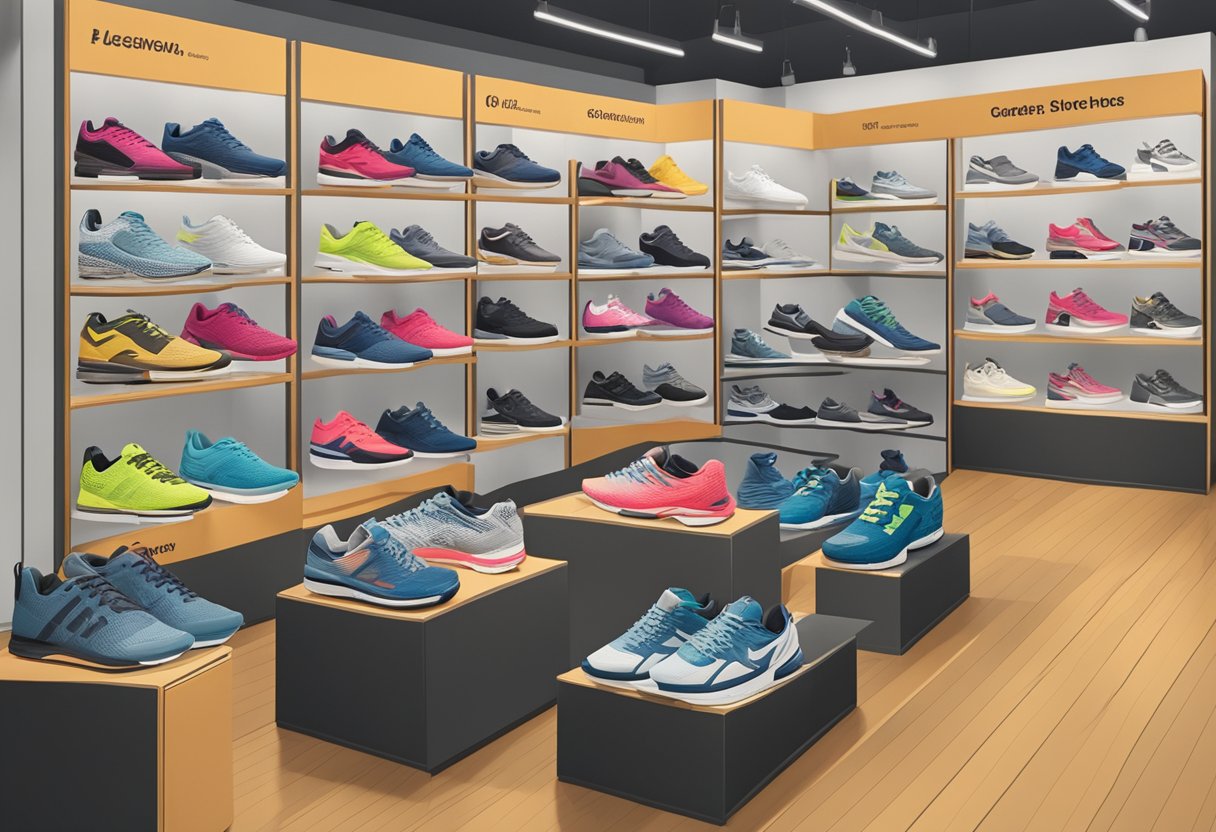Choosing the right athletic shoes is essential for comfort, performance, and injury prevention. The array of options can be overwhelming, but finding the ideal pair is a matter of understanding your own needs. Consider your foot mechanics and how different shoes cater to various movements. Whether for professional sports, casual jogging, or even just day-to-day walking, picking a shoe that aligns with your activities and foot structure is key. This will help ensure you’re supported where you need it most.
Athletic shoes come in numerous forms, each suited to specific activities—knowing whether walking shoes or running shoes best fit your lifestyle is an important distinction. Also, consider your own foot anatomy such as flat feet or high arches, and how that impacts your choice. The midsole of the shoe plays a crucial role in cushioning and support, while proper fit and the quality of materials can greatly enhance comfort and shoe lifespan. Being well-informed can lead to a smart investment in your athletic footwear, ultimately providing a better, safer experience during your fitness journey.
Key Takeaways
- Appropriate athletic shoes support foot mechanics and cater to specific activities.
- Identifying personal foot characteristics helps in selecting shoes for comfort and injury prevention.
- Evaluating shoe quality and fit ensures lasting comfort and protects against common foot ailments.
Understanding Foot Mechanics
Selecting the right athletic shoes requires a fundamental understanding of foot mechanics. This section will cover the anatomy and movements of the foot, how to determine your specific foot type, and the role pronation plays in your overall gait.
Anatomy and Biomechanics
The foot is a complex structure made up of bones, muscles, tendons, and ligaments that work together to support the weight of the body. Biomechanically, the ankle acts as a pivot point for movement, while the arches of the foot play a critical role in absorbing impact and aiding in propulsion. Whether running or walking, each part of the foot from the heel to the toe box contributes to overall foot mechanics.
Identifying Your Foot Type
Understanding your foot type can lead to better shoe choices and enhance comfort. A wet test can reveal if you have flat feet or a high arch, both requiring different types of arch support. Individuals with flat feet tend to have a lower arch, potentially leading to overpronation, while those with high arches may underpronate and will need additional cushioning.
Pronation and Its Impact on Your Gait
Pronation is the foot’s natural inward roll following a heel strike. Normal pronation helps with shock absorption. Overpronation, where the foot rolls too much inward, or underpronation, where there is not enough roll, can both affect one’s gait and increase the risk of injury. Recognizing your level of pronation can inform the right choice of shoe, where adequate arch support and heel stabilization are key factors for those who overpronate, and flexible cushioning is essential for underpronators.
Choosing the Right Running Shoes
When selecting the right running shoes, it is essential to focus on the fit, cushioning, support, flexibility, and upper construction to ensure comfort and performance during a run.
The Importance of a Proper Fit
A proper fit is paramount for running shoes; it’s about more than just the shoe size. Runners should ensure that there is a thumb’s width of space between the longest toe and the end of the shoe, providing enough room for foot movement and expansion during runs. The heel should fit snugly with no slippage, and the midfoot area should comfortably hug the arch without being too tight.
Key Factors for Proper Fit:
- Toe Box: Adequate space to prevent cramping.
- Heel: Secure fit with minimal movement.
- Midfoot: Comfortable yet supportive grip.
Cushioning and Support Features
Cushioning in running shoes is designed to absorb impact and provide comfort. However, the amount of cushioning required varies; a highly cushioned shoe offers more comfort but less ground feedback, while less cushioning can provide a better road feel. Similarly, the level of support will depend on individual foot types and running styles. Overpronators require more support for stability, while neutral runners may opt for a less structured shoe.
Cushioning Levels:
- Maximum: High level for comfort-focused runners.
- Moderate: Balanced cushioning for many runners.
- Minimal: For those desiring ground feel and flexibility.
Considering Shoe Flexibility and Upper Construction
The flexibility of a running shoe contributes to a natural footstrike and efficient movement, with more flexible shoes often offering a better sense of the terrain. The upper construction plays a role in how well a shoe will fit and conform to the foot, with materials ranging from stretchy meshes to structured synthetics.
Aspects of Flexibility and Upper:
- Flexibility: Affects foot movement and ground interaction.
- Upper: Determines the overall fit of the shoe.
Selecting the right running shoe is integral to a runner’s experience. Every element, from the fit to the cushioning, support, flexibility, and upper construction, plays a critical role. Runners must consider their unique needs to find the most comfortable, supportive, and cushioned shoes that enhance their running performance.
Athletic Shoe Varieties
Selecting the right athletic shoe is critical for comfort and performance. This section focuses on understanding the diversity of athletic shoe options available and the features they offer, tailored to various activities and technological advances.
Specialized Shoes for Different Activities
Athletic shoes are crafted with specific activities in mind. Running shoes, for example, are built for forward motion and offer ample cushioning for shock absorption. Basketball shoes provide extra ankle support to accommodate the sport’s frequent lateral movements and jumps. Tennis shoes feature a more flat sole for agility and speed across the court, while cross-training shoes are versatile, designed for a balance of running, weight lifting, and other activities within a workout regime.
Innovations in Athletic Shoe Features
The athletic shoe landscape is continuously refined by innovation. Key developments include varying levels of motion control and stability shoes, tailored to individuals with overpronation or supination issues, giving the right amount of support and alignment. Minimalist shoes strip back design to mimic barefoot running conditions, providing little to no arch support and a thin sole. Athletic shoes now often integrate advanced materials and design that align with the feet’s natural movement, enhance breathability, and offer durable traction.
Walking Shoes vs Running Shoes
When considering athletic footwear, it’s essential to distinguish between walking shoes and running shoes. Each is designed with specific characteristics that cater to the unique demands of its activity.
Design Differences and Their Effects
Walking shoes are crafted with the understanding that the walker has a consistent foot contact with the ground. They typically have a flexible sole which is designed to allow the foot to roll naturally from the heel through the toe. Moreover, walking shoes are often constructed with an emphasis on support, with a slightly beveled heel to aid in the smooth, rolling motion.
Running shoes, on the other hand, are optimized for a different kind of impact. As runners experience a moment where both feet are off the ground, running shoes provide a greater level of cushioning to absorb the higher impact. They have a thicker heel with increased heel height to address this unique stress. Running shoe soles also have a different structure, designed to withstand the greater impact and to provide traction during faster movements.
Lightweight materials are a common feature in both walking and running shoes. However, running shoes often employ even lighter materials to facilitate speed and lessen fatigue over distance. The difference in materials affects the level of support and flexibility of the shoe, with running shoes often offering more structured support.
A runner should never substitute walking shoes for running shoes or vice versa. The specific design of each shoe type plays a critical role in the comfort and support needed for the intended activity.
Injury Prevention and Shoes
Selecting the right athletic shoes is crucial for injury prevention. Shoes that offer proper support and fit can reduce the risk of common sports injuries such as shin splints and plantar fasciitis.
Choosing Shoes to Prevent Common Injuries
When selecting athletic shoes, one should consider features that prevent common injuries. Arch support is critical; lacking it can lead to plantar fasciitis and heel pain. A shoe with appropriate arch support will distribute pressure evenly across the foot. For activities involving a lot of running or impact, such as basketball or tennis, look for shoes that feature adequate ankle support to mitigate the risk of rolling or twisting an ankle.
- Shin splints: Seek shoes with good cushioning and flexible soles.
- Heel pain: Ensure the insole offers supportive contouring.
- Stress fractures: Choose shoes with a balance of cushioning and stability.
Proper cushioning and the right fit are essential to overcome the forces that might lead to tendonitis or other overuse injuries. Shoes should be tailored to the sport; for example, running shoes are typically built to absorb repeated impact, while court sports shoes focus on lateral support.
Shoe Choices for Pre-existing Foot Conditions
Individuals with pre-existing foot conditions require shoes that accommodate and counteract their conditions. Conditions such as arthritis, hammertoes, and complex disorders require shoes that reduce joint stress, provide space for deformities, and support the foot structure.
- Arthritis: Opt for shoes with a softer sole and good shock absorption to reduce pressure on joints.
- Hammertoes: Shoes with a spacious toe box prevent additional toe strain.
For those suffering from tendonitis or plantar fasciitis, specialized shoes with firm heel counters and ample arch support can aid in recovery and prevent further aggravation of these conditions. It is imperative to opt for athletic shoes that not only fit well but also align with the specific demands and mechanics of the wearer’s feet and their chosen activity.
Footwear for Flat Feet and High Arches
When selecting athletic shoes, one must consider if they have flat feet or high arches as this greatly influences the type of foot support needed.
Optimal Features for Support and Comfort
Flat Feet: Individuals with flat feet should look for shoes that offer ample arch support and stability. A low or flat arch requires more support to prevent the foot from rolling inwards. Shoes designed with a structured heel cup and firm midsoles enhance stability. For instance, the selection at Shoes for flat feet: 11 of the best – Medical News Today showcases ideal footwear that provides the necessary support for flat arches during athletic activities.
High Arches: Conversely, those with high arches need shoes with a cushioned midsole to absorb shock efficiently. A curved, cushioned sole helps to distribute impact and alleviate pressure on the forefoot and heel. For additional comfort, ample cushioning along the insole is also important. Resources like How to determine foot arch type – Mayo Clinic Health System can be instrumental in identifying the right shoe fit for high arches.
Selecting Custom Orthotics
Sometimes generic athletic shoes might not meet specific individual needs for those with flat feet or high arches. In such cases, custom orthotics are a viable option. They are tailor-made insoles that precisely fit the contours of one’s feet, providing personalized support where it’s needed most.
For flat feet, orthotics should focus on enhancing medial stability while offering arch support to distribute weight evenly. High arched feet benefit from orthotics that offer a combination of support and enhanced cushioning to address the lack of natural shock absorption.
It’s always recommended to consult with a healthcare professional or a specialized footwear expert when considering orthotics. For example, guidance can be found on High Arches? Pick The Right Shoes – WebMD to ensure that the custom insoles cater to specific arch-related requirements, thereby ensuring optimal functionality and comfort.
The Role of Shoe Midsoles
The midsole of an athletic shoe plays a critical role in providing cushioning and stability for the foot. It’s a foundational element that influences both comfort and performance during physical activities.
EVA and Other Midsole Materials
Midsoles are commonly made from a variety of materials, the most popular being Ethylene-Vinyl Acetate (EVA). EVA is favored for its light weight and cushioning properties, effectively absorbing impact as the foot strikes the ground. However, not all EVA is created equal; manufacturers often use different formulations to balance softness and responsiveness. Some shoes incorporate polyurethane for a denser and more durable midsole, although they tend to be heavier. A new trend is the inclusion of specialized foams or gel-based systems that further enhance cushioning and extend the lifetime of the shoe.
Function of the Heel Counter and Stability Control
The heel counter is an embedded structure in the midsole that cradles the heel of the foot. This feature provides a secure fit, enhances stability, and supports the rear foot during motion. Shoes designed with motion control are built specifically for individuals who exhibit overpronation. They are typically categorized as stability shoes and are engineered with a dual-density midsole—firmer foam in the arch area—to correct the excessive inward roll of the foot. Stability shoes help distribute the impact more evenly, which can prevent injuries and improve gait efficiency. These design elements are crucial for athletes who require extra support due to flat or low arches.
Shoe Fit and Comfort Enhancements
Proper shoe fit and comfort enhancements are pivotal for maximizing performance and preventing injuries. These aspects are influenced by elements such as sock liners, insoles, and lacing techniques.
Exploring Sock Liners and Insoles
Sock liners and insoles play a critical role in providing a comfortable shoe environment. Sock liners are the thin layer inside shoes that can provide additional cushioning and moisture-wicking properties, enhancing the overall feel. For individuals seeking tailored support, insoles can be a game-changer. They come in various materials and designs, such as foam or gel, offering different levels of arch support and cushioning. It’s essential to choose an insole that complements the natural shape of one’s foot, which can mitigate common complaints like plantar fasciitis.
The Effect of Lacing Techniques on Shoe Fit
The manner in which a shoe is laced can dramatically affect both fit and comfort. Standard lacing techniques may work well for the average foot, but variations in foot anatomy often call for customized lacing strategies. For instance, those with a high instep may find relief by employing a ‘window’ lacing technique to alleviate pressure on the top of their foot. Conversely, individuals with narrow heels might benefit from ‘lock’ lacing to prevent heel slippage. Proper lacing ensures a secure fit, minimizing movement within the shoe and reducing the chance of blisters or other discomforts.
Recognizing Quality Athletic Footwear
When choosing the right athletic shoes, discerning the quality of the footwear is crucial. Factors like material robustness, brand reliability, and informed endorsements play pivotal roles in the decision-making process.
Material and Build Quality
Quality athletic shoes are characterized by their material and build quality. High-grade materials such as engineered mesh for breathability, durable rubber outsoles for traction, and responsive cushioning for comfort are sought after in shoes. For example, New Balance utilizes advanced foam compounds in their midsoles for enhanced durability and performance, while Nike often features innovative technologies like Flyknit for a lightweight, yet supportive, fit.
- Upper Material: Should be flexible, breathable, and durable.
- Midsole: Must offer good cushioning and motion control.
- Outsole: Needs to have adequate grip and be made from long-lasting material.
Brand Reputation and Expert Recommendations
Purchasing from reputable brands like Adidas, Asics, or the aforementioned Nike and New Balance can often lead to satisfaction due to their commitment to quality. Expert recommendations from podiatrists or running coaches are invaluable, as they understand the biomechanics involved in athletic activities. These brands are found in specialty stores where staff can provide insightful research and information on the latest innovations. Shoes from these brands might be expensive, but paying a premium often ensures better quality and longevity of the footwear.
- Experts: Value their guidance on the latest in shoe technology and fit.
- Research: Read and compare customer reviews from reliable sources.
- Specialty Store: Get a personalized fitting and expert advice.
Savvy Shoe Shopping
When selecting athletic shoes, the buyer should focus on two key practices: conducting a thorough test run and understanding the return policies.
How to Conduct an Effective Test Run
A test run is critical in determining the suitability of athletic shoes. One should lace up the shoes with their usual socks to ensure proper fitting. During the test, they need to pay attention to the shoe’s performance during movements mimicking their intended sport or activity. The shoe should feel comfortable immediately without the need for a ‘break-in’ period. A shoe size that allows for about a half-inch of space from the big toe to the tip of the shoe is ideal.
Understanding Return Policies
Before purchasing, customers must acquaint themselves with the store’s return policy. A comprehensive return policy can include a trial period during which the shoes can be returned if they do not provide a proper fit or desired comfort. It’s advisable to retain all original packaging and receipts, as many stores require these for a successful return.
Conclusion
Selecting the right athletic shoes is crucial for both comfort and performance. One should look for features such as unique design that suits individual style and responsive cushioning that adapts to one’s movements. Shock absorption is key to protect the joints during high-impact activities, therefore, ensure that the shoes chosen have adequate padding.
They should also consider the distribution of pressure points; a good athletic shoe will distribute weight evenly to minimize stress on any single point of the foot. It’s important to remember that the right shoe can make a significant difference in athletic performance and injury prevention.
Below are some final recommendations:
- Fit: Ensure there is a thumb’s width of space between the longest toe and the end of the shoe.
- Support: The midsole should offer a balance between firmness and cushioning.
- Durability: Seek out shoes that are made with quality materials that will withstand your sport or activity.
When making a final decision, they may wish to consult with a specialist at a running or sporting goods store who can provide a gait analysis to further tailor the shoe selection to their specific needs.
In summary, finding the perfect athletic shoe is a blend of understanding one’s unique foot mechanics, choosing responsive cushioning, ensuring effective shock absorption, and acknowledging pressure points.
Frequently Asked Questions
When shopping for athletic shoes, consumers often have questions about the differences between shoe types, selecting reputable brands, and identifying the right fit. This section provides concise answers to common queries about athletic footwear.
What are the key differences between various types of athletic shoes and their specific uses?
Athletic shoes are designed with specific activities in mind. Running shoes, for example, offer cushioning for repetitive strides, while basketball shoes provide ankle support and a flat sole for stability. Understanding these differences will guide users in selecting the right shoe for their sport or activity.
How can you identify the best athletic shoe brands that cater to your needs?
The best athletic shoe brands excel in quality, durability, and comfort. Good brands typically specialize in certain types of footwear, providing targeted technologies and design elements for each sport. Researching and reading reviews from other athletes can lead to informed decisions about which brands will cater to one’s individual needs.
What are the top factors to consider when selecting road running shoes for men?
Selecting road running shoes should involve consideration of the runner’s foot shape, gait cycle, and cushioning preferences. One should also consider shoe weight, breathability, and outsole traction designed for pavement. Males often find that choosing a shoe that offers adequate support and fits well is crucial to enhance their running experience.
What are the essential tips for beginners to find the perfect running shoes?
Beginners should prioritize fit and comfort over style. They should look for running shoes with enough toe room and appropriate arch support. It’s important to try on shoes later in the day when feet are more swollen from daily activities to ensure a proper fit.
What criteria should be used to determine the correct sizing for running shoes?
Proper sizing for running shoes ensures there’s about a half-inch of room between the longest toe and the shoe’s front. This allows room for the foot to swell during runs. Additionally, the width of the shoe should be snug but not tight, preventing unnecessary movement that could lead to blisters.
What should consumers look for in athletic shoes if they have conditions like plantar fasciitis?
For conditions like plantar fasciitis, consumers should search for shoes with good arch support, a cushioned sole, and a comfortable fit. It may also be beneficial to seek shoes with a deep heel cup and firm midsole to reduce stress on the plantar fascia. Consulting with a healthcare professional and reading medical advice on footwear can provide additional guidance.






